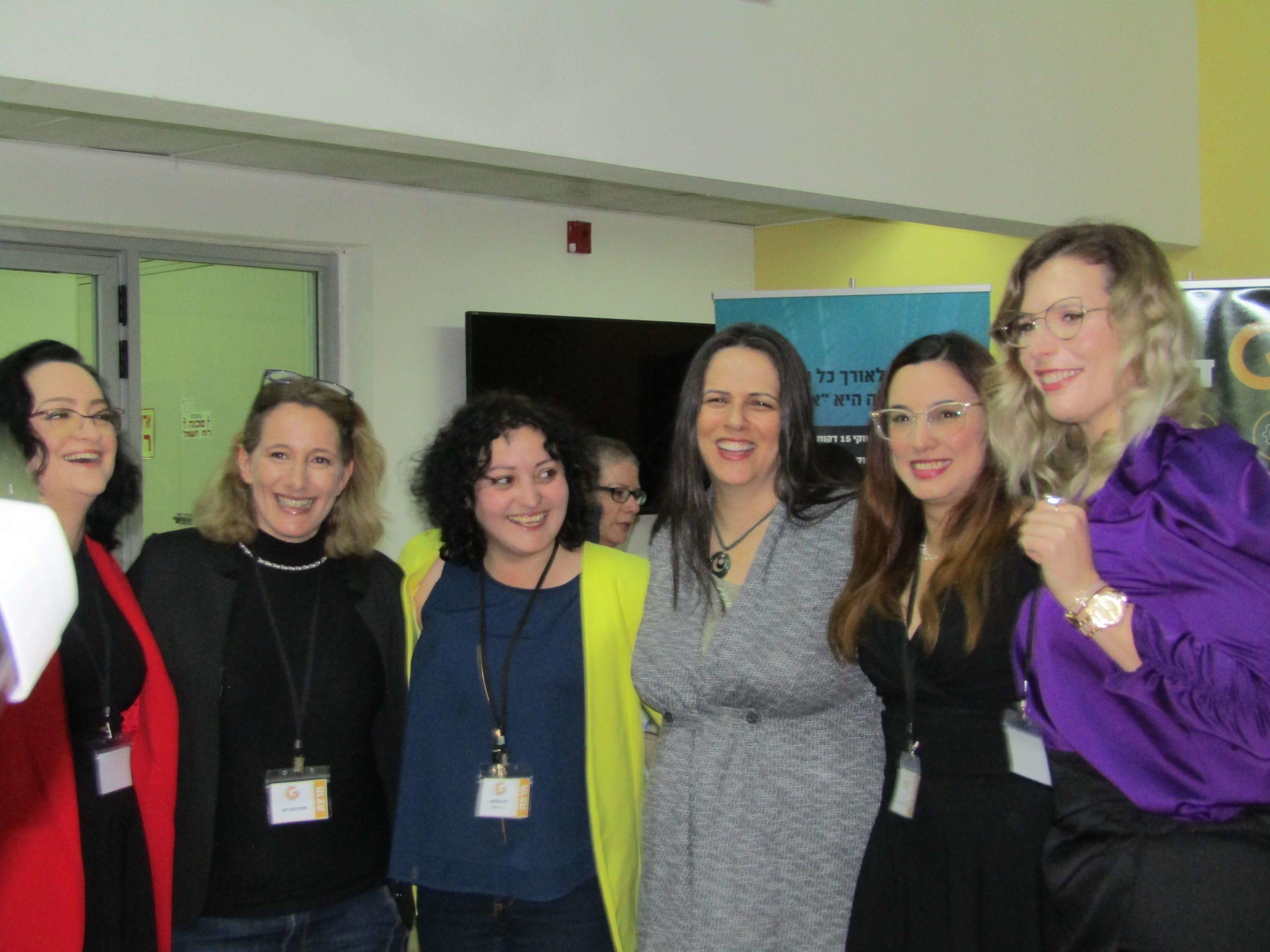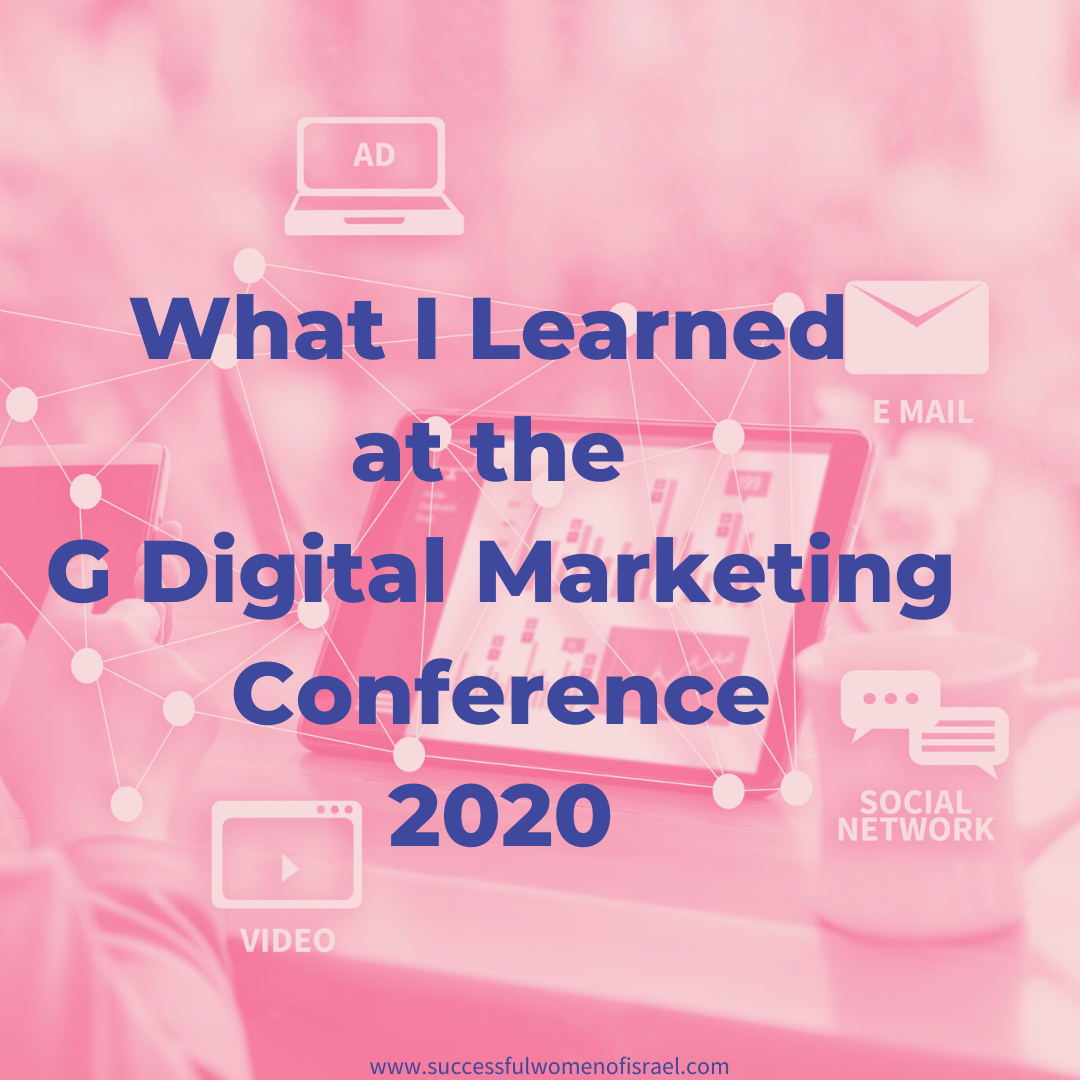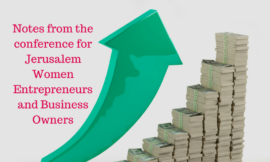Ana Gelfman, is the an automation expert and owner of G Shivuk Digitali. She is also the sponsor and organizer of the G Digital Conference. Ana graciously invited me to her amazing two-part conference.
Digital marketing is constantly changing, and as a result there are constantly new players and new ways of playing the digital marketing field. The G Digital Conference stands out for its great speakers and presentations. I learned a ton, and no doubt I will keep referring to this blog post to up my own game.
I will add, that because of the Covid-19 pandemic, now is a great time to take advantage the world’s downtime to catch up on things we never have time for – i.e. learning the ins and out of digital marketing.
There were two parts to the conference, which took place a week apart at the end of February. Sadly, I could only attend the first part of the conference because of a pinched nerve which put me out of commission for a month – and which is why it’s taken me so long to create and upload this post.
Now that you’ve gotten through the intro, keep reading to learn how you can improve your business outcomes using digital marketing.
Google, Facebook, Taboola & Co. – Lee Levi
Lee Levi, gave a fantastic talk about social media advertising using Google, Facebook and Taboola.
Her talk was packed with tips about the differences between the different platforms, when you should pay for advertising on each platform, and general rules to follow.
If you’re considering a paid advertising campaign on social media here are some of the things you need to know:
1. Paid advertising requires a strategy
Advertising is advertising. And that means you need a strategy. So many people think that because advertising on social media is much cheaper than advertising on TV or in a print magazine, you don’t need to be intentional about it. Except that you do. Because if you’re not, you’re simply wasting money.
2. Consistency is key
Yes, you require a strategy. But your strategy will only work, if you’re consistent. Spending 300NIS (approximately 88 USD) one month, and spending none the next, will not yield results. In fact, ask Lee, and she’ll tell you you’re wasting your money if you spend less than 1000NIS (approximately 293 USD) a month on paid advertising. And if you do decide to spend so little on paid advertising, learn to do it yourself.
3. Remember the funnel
For your advertising to be effective you constantly have to keep your funnel in mind. Understanding your funnel and who your target audience is, will keep you focused on the type of message you need to convey.
Lee shared the four-stage funnel around which she models her campaigns:
i. Awareness
ii. Consideration
iii. Conversion
iv. Preservation
4. Different paid platforms are good for different levels of the funnel
Top level of the funnel – awareness
Taboola Outbrain – $1 per click
This is a great platform to use to understand who your target audience is.
It’s perfect for top of the funnel when you’re working on gaining awareness.
Here your content is important. Find out who’s reading – who is interested in what you’re providing. This is not the place to sell. It’s the place to find out who your content is attracting.
The second level of the funnel – consideration
What you’re going for, in this part of the funnel, is consideration. You want to show yourself more – the advantages of working with you.
Here the best platforms to use are YouTube, Instagram, Facebook and LinkedIn.
Your target audience is people who have already visited your website.
The third level of the funnel – conversion
Now it’s time to convert your target audience into buyers.
People who have put items in their basket but have not completed the purchase; those who have spent time on your site; loyal customers and/or those who have signed up for your membership site/club.
Types of content good for this part of the funnel:
Canvases, carousels, Google shopping, catalogues
Bottom of the funnel
This is about customer retention.
Offering complementing products – upselling. It requires very clear targeting.
Having said all that, Lee points out that while advertising on social media may be much cheaper than advertising on TV, on a billboard or in a print magazine, that doesn’t mean you should make haphazard decisions about your advertising.
Content Marketing That Roars – Michal Abramovici
Make people want to get in touch with you, by letting them know why you do what you do.
Michal offers another variant of the funnel:
i. Discover
ii. Like
iii. Trust
iv. Buy
Michal offers to guidelines for getting started:
- Get over the discomfort of being unique
- Stop counting how many likes you get on Facebook
Get your story started with these questions
But content marketing begins with a blank page. Blank pages are difficult for writers and non-writers a like. To help everyone get started, Michal offers a great starting point – ask questions about what you want to write:
- What? What happened?
- Who? Who’s involved?
- When? When did it happen?
- Where? Where did it happen?
- Why? Why did it happen?
Answering these questions in any piece you write, will help the flow going. It can also help you figure out which Facebook groups are relevant to your story.
Tricks to writing great headlines
Use numbers – they trigger readers’ minds to an understanding that you’re about to provide them with specific information about a subject.
Be decisive – people aren’t looking for wishy-washy. You’re the pro, and people are coming to you looking for decisive answers.

From Excuses to Automation – Ana Gelfman
“I don’t have time.”
Sound familiar. It should. Ana shared that this is the most common phrase spoken by business owners in 2019 (in the context of digital marketing).
In this talk, Anna shared some great tools that will help you do different things, to save time that you just don’t have.
Business owners today don’t have the luxury of not being digitally present. Because if you’re not consistently present, you disappear.
Customers and clients simply are not aware of businesses that do not market digitally.
But now that Ana’s established that you must be digitally present, what’s the way to do it?
- Be persistent
- Automate
The way to think of automation:
- What do I want to accomplish? What do I need to accomplish what I want?
- What is the ideal solution?
Now build an automation process that will take you from what you want to accomplish to your ideal solution.
Excuse no. 1 – “I don’t have time”
Toggl – this is a great time tracker and I love that Ana shared it because it’s one of my personal favourites.
Trello – this is another great tool that I use. Ana suggested using it as a gant chart and syncing it with your calendar to help you get big projects done.
Gmail – Use gmail to schedule when you send out your emails.
Excuse no. 2 – “the digital world is not for me”
If you don’t have the budget to have a professional handle your digital assets for you, you’re going to have to figure it out for yourself.
In today’s world there are no excuses for ignorance. The world wide web is an information highway, and no doubt there are a plethora of digital courses, blogs and sites filled with content to help you learn. Ana’s advice is to get out there and start learning. The digital world is here to stay.
Excuse no. 3 – “most of my clients get to me by word of mouth”
Ana warns that without digital advertising, you simply won’t be remembered. She urges businesses to create compelling content marketing assets that will grab clients and use Facebook’s Creator’s Studio to reach your audience more effectively.
And if you really want most of your clients to come to you by word of mouth – content marketing is an absolute must!
Excuse no. 4 – “but I’m just one person”
Ana’s recommendations:
- Use Zapier to collect leads and synchronize them with Google Sheets
- Use a gant chart to collect leads, link it to Facebook and synchronize with Google Sheets
- Collect leads from a landing page and synchronize it with Google Sheets
- Collect are your leads into one file and send them all an automated message using your email client
Excuse no. 5 – “I don’t have a marketing budget”
Ana recommends finding the tools you need. No marketing budget? Ana suggests exchanging time for knowledge. Find someone to teach you the skills to help you improve your digital marketing skills. In addition, there are plenty of groups for marketers on Facebook and WhatsApp where you can ask questions and learn from those more experienced than you. You can also create partnerships with other professionals who complement your skills.
5 Tips to Creating a Winning Landing Page – Maayan Cohen-Rozen
Before beginning to create the copy for your landing page, spend time understanding who your target audience is. Once you know who your target audience is and what you want to offer them, here are five tips that will help you.
-
Create a message that is clear, concise and precise
This is pretty self-explanatory. And yet creating a message that is clear, concise and precise is hardly trivial. In my work as a copywriter, I can tell you that it can take a workshop or long conversations to get to the gold that will attract your target audience. But a clear, concise and precise message is what you’re going for if you want people to respond to your call to action – which is the whole point of your landing page.
-
Less is more
This is ties in with Maayan’s first point, but it’s a bit different. Maayan shared (and this has been my experience as well), that clients want to use their landing page to tell you everything about their product. But that’s a terrible strategy. Providing too much information gets in the way of creating a super-sharp and targeted message that will resonate with your target audience.
-
A/B Testing
With the internet, there’s no reason to guess. You can measure everything. Try using different images, changing colours, changing the position of different elements in your landing page, and changing up the copy. A/B test everything – but make sure that each time you only change one element, otherwise you won’t know what worked.
-
One call to action
The point of your landing page is to get your target audience to take action. Don’t muddy up your invite to a webinar by asking your audience to go to your website. Whatever it is you’re asking your target audience to do, make sure that the button is big enough and clear enough. And if you really want them to go to your site – add a link to the thank you page – after they’ve already signed up.
-
Your funnel flow
Want your target audience to press that button? Warm them up. By the time your prospects see your landing page, they should have already have some information about you – what you do, what you offer, and why they may be interested. Every stage in the funnel is important. So make sure that by the time your target audience reaches your landing page you’ve make it clear why you are worth learning from and/or buying from. Once you get to the landing page, you’ll be able to be super-concise with your message.
Using Your Price Quote as a Tool for Achieving Business Success – Vera Orman
This talk by Vera was fascinating, as she broke down the various elements of a price quote and how it could be used to achieve business success.
The most fundamental part of business is to be able to collect. While it sounds totally obvious, we don’t often break down a business to it’s lowest common denominator – getting paid.
- Getting paid is something that has to be built in to your price quote so that it is clear beyond a doubt how and when it is to take place.
- Coordinate expectations with your client. Assume that your client doesn’t know anything about how your business works. A client who doesn’t understand how your business works, and what they will be receiving for what they pay, simply will not do business with you.
- Own your process. Whether a client comes to by word of mouth, or through an internet search, make sure that the process of onboarding a client is the same.
- Hone and improve your work process. Whether the project went well or whether it didn’t, ask your clients about it. If you ask yourself, you’ll most certainly be able to answer what went well and what didn’t – this will help you improve the process for next time.
- Package your process in your price quote. Here’s where it gets really interesting. Because the elements just spoken are built into the structure of the price quote Vera presents:
The structure of a winning price quote:
- What is the client getting – this includes details about the product or service the client will receive.
- What will the client provide in exchange for the services rendered – include the fee and terms of payment
- Warranties, guarantees and the small details – there is always fine print. What does your product or service include? What does it not include? Make it clear.
- Cancellation terms – you know how a project starts, you don’t know how it will end. Don’t enter an agreement you don’t have a way out of.
- Your price quote is a reflection of your professionalism. Make sure it is in tip top shape and a document you are proud of.
After all that, Vera shares a few more musts:
- Make sure your price quote is clearly written and easy to understand.
- The proposal should be as short as possible
- Branding – your price quote should have your logo and all your contact details
- Your clients full details
- Don’t forget the date and an expiration date
- Don’t begin work without the signature of your client on the price quote (in Israel this has far reaching consequences. In the case of a signed price quote and a client who doesn’t pay – Israel’s debt collection agency can do the collecting for you).
(Disclaimer: This is not intended as legal advice. For legal advice seek qualified professional legal counsel.)
This G Digital Conference was absolutely packed with value – and there was a second part of the conference, which I unfortunately could not attend. But if you live in Israel, and/or speak Hebrew, make sure to visit Ana Gelfman’s website and follow her on Facebook. This is a conference you won’t want to miss in 2021, when life gets back to normal.



Thank you for this
Thank you for reading, Rickey – I hope you enjoyed it!